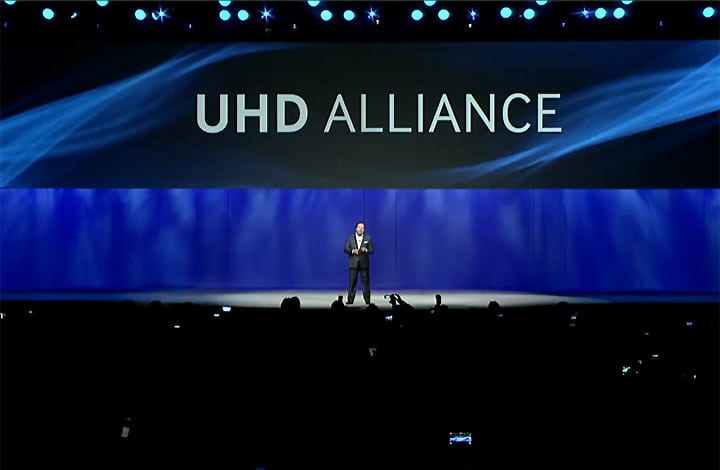Latest News

Samsung’s Executive Vice President for North America, Joe Stinziano, introduces UHD Alliance at CES 2015. Photo: Samsung
[Via Satellite 04-16-2015] The Ultra High Definition Alliance (UHD Alliance) is coming to make sure Ultra-HD makes it to a screen near you and with lasting power. As 4K looks to take over HD and enter the mainstream as a newer, clearer and more sensational way of delivering media to consumers, companies across the industry are coming together with the aim to streamline an approach to standards, logos and technologies for the budding tech.
The newly formed and still-growing UHD Alliance boasts names such as Samsung, Warner Bros., Netflix, DirecTV, Technicolor and countless others who are hoping to use the alliance to ensure that all products meet the same standards across the Ultra-HD ecosystem as it continues to evolve.
“The ultimate goal of the alliance is to optimize the most premium consumer media experience and drive broader adoption of next-generation technologies,” Vince Pizzica, Technicolor’s senior executive vice president of corporate development and technology, told Via Satellite. “Innovations under the UHD Alliance umbrella include resolution of 4K and beyond, high dynamic range, wider color gamut, high frame rate, and immersive audio.”
According to Pizzica, another aim of the UHD Alliance is to define the quality requirements for an Ultra-HD experience and to establish and communicate quality standards for new video technologies that will allow industry participants to “align and seamlessly integrate their offerings.” Moreover, the alliance hopes to provide a certification regime for 4K, although setting actual certification standards are still out of reach.
“Contrary to popular belief, the UHD Alliance is not there to actually set standards for next generation video technology as there are official organizations like the [Consumer Electronics Association] CEA and [the Society of Motion Picture and Television Engineers] SMPTE for that,” said David Watkins, director of connected home devices at Strategy Analytics. “The hope is that the member companies will agree on the best approach for these technologies so that their different offerings will interoperate seamlessly.”
Another aim of the UHD Alliance is to develop branding and logos in order to distinguish the products that allow consumers to view content in Ultra-HD. Watkins believes this will be key in driving consumer adoption.
“Past experience with HD branding has shown that this gives consumers confidence to go out and invest in a product safe in the knowledge that it has the weight of industry support behind it,” he told Via Satellite.
Setting those standards could be more crucial than ever as the CEA predicts a sharp uptick in 4K Ultra-HD TVs sold in 2015 over the 1 million units sold last year. The upsurge is the direct result of increased availability of higher resolution screens combined with falling prices. Content providers are also upping the viewer’s ability to access 4K content, with Over-the-Top (OTT) vendors such as Netflix already streaming Ultra-HD and traditional production companies following on their heels. A myriad of satellite operators such as Sky Perfect JSAT, Hispasat, Eutelsat and SES are in various stages of trialing 4K channels.
“We’re seeing increases in the number of shows for which Technicolor is handling post-production in native 4K. In 2014 it was just one or two, but this year we expect up to 10 times as many shows produced in 4K, and many with [High Dynamic Range] HDR as well,” said Pizzica.
The alliance held its first official meeting in January and made its official call for other contributor members to join and help create 4K specifications on April 6, but they have yet to reveal what those final specifications may look like. While the alliance looks to include companies from across the workflow, such as studios, distributors, and consumer electronics companies, among others, Pizzica sees the satellite industry as having a particularly important role in 4K adoption.
“The satellite industry has a unique opportunity to introduce and encourage 4K Ultra-HD content because of the bandwidth efficiency of broadcasting,” Pizzica said, noting that Technicolor has developed MPEG-based encoding technologies to allow a single broadcast to include both 4K and 1080p signals as well as Standard Dynamic Range (SDR) and HDR — something he calls the “holy grail of backwards compatibility and protection for future technologies.”
“As consumers adopt next generation TVs over the next few years and decades, it’s important to find efficient use of bandwidth to support that roll out without having to swap out consumer receivers and dish equipment. We’re very sensitive to the economics of the pay-TV industry and the expense of rolling a truck to have to replace consumer premise equipment when the subscriber upgrades to a new 4K or HDR display,” said Pizzica.
Watkins believes the alliance is perhaps two years too late, but is ultimately a good thing for the industry, although its success hinges on whether members can agree on a set of common guidelines.
“Many of the current members have spent a lot of time and money on developing their own proprietary standards for technologies such as a high dynamic range and color,” said Watkins. “Those companies must be willing to compromise and potentially forego years of in-house [Research and Development] R&D in order to settle on a common approach.”
Get the latest Via Satellite news!
Subscribe Now